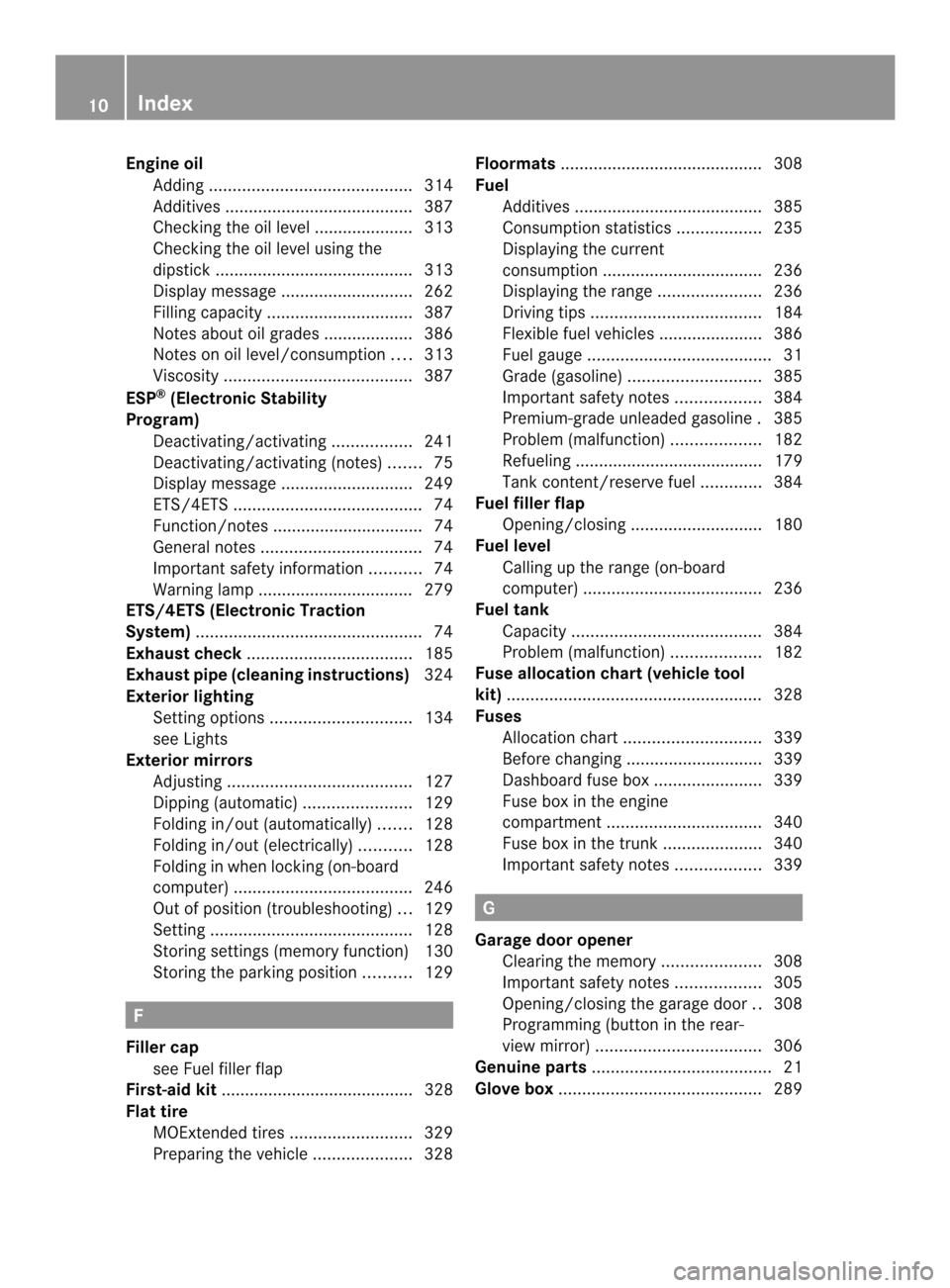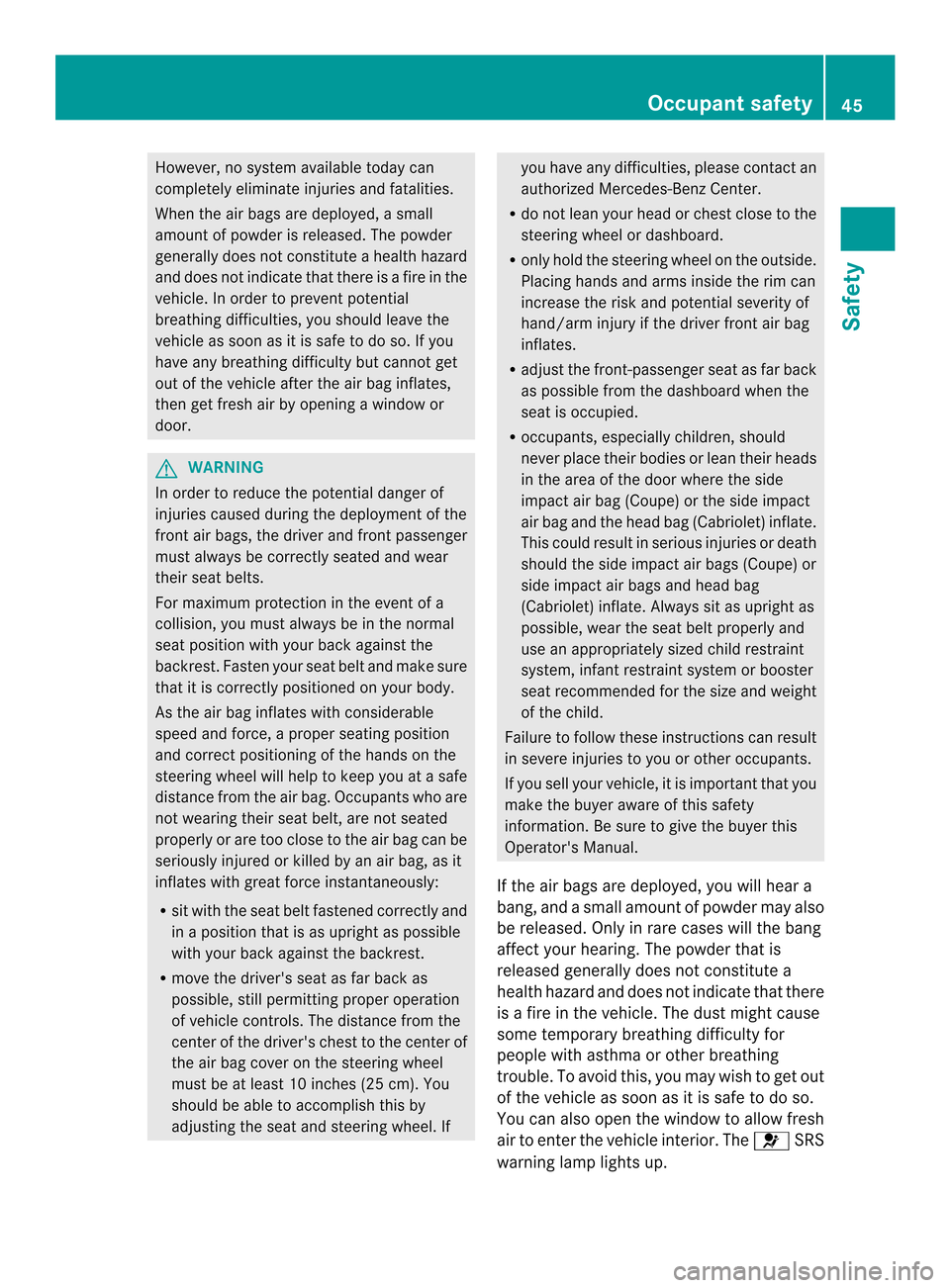dashboard warning lights MERCEDES-BENZ E-Class CABRIOLET 2014 C207 Owner's Manual
[x] Cancel search | Manufacturer: MERCEDES-BENZ, Model Year: 2014, Model line: E-Class CABRIOLET, Model: MERCEDES-BENZ E-Class CABRIOLET 2014 C207Pages: 394, PDF Size: 5.28 MB
Page 12 of 394

Engine oil
Adding ........................................... 314
Additives ........................................ 387
Checking the oil level ..................... 313
Checking the oil level using the
dipstick .......................................... 313
Display message ............................ 262
Filling capacity ............................... 387
Notes about oil grades ................... 386
Notes on oil level/consumption ....313
Viscosity ........................................ 387
ESP ®
(Electronic Stability
Program) Deactivating/activating .................241
Deactivating/activating (notes) .......75
Display message ............................ 249
ETS/4ETS ........................................ 74
Function/notes ................................ 74
General notes .................................. 74
Important safety information ...........74
Warning lamp ................................. 279
ETS/4ETS (Electronic Traction
System) ................................................ 74
Exhaus tcheck ................................... 185
Exhaus tpipe (cleaning instructions) 324
Exterior lighting Settin goption s.............................. 134
see Lights
Exterior mirrors
Adjusting ....................................... 127
Dipping (automatic) .......................129
Folding in/ou t(automatically) .......128
Folding in/ou t(electrically) ...........128
Folding in whe nlocking (on-board
computer) ...................................... 246
Out of position (troubleshooting) ...129
Setting ........................................... 128
Storing settings (memory function) 130
Storing the parking position ..........129 F
Fille rcap
see Fuel filler flap
First-aid kit ......................................... 328
Flat tire MOExtended tires ..........................329
Preparing the vehicle .....................328Floormats
........................................... 308
Fuel Additives ........................................ 385
Consumption statistics ..................235
Displaying the current
consumption .................................. 236
Displaying the range ......................236
Driving tips .................................... 184
Flexible fuel vehicles ......................386
Fuel gauge ....................................... 31
Grade (gasoline) ............................ 385
Important safety notes ..................384
Premium-grade unleaded gasoline .385
Problem (malfunction) ...................182
Refueling ........................................ 179
Tank content/reserve fuel .............384
Fuel filler flap
Opening/closing ............................ 180
Fuel level
Calling up the range (on-board
computer) ...................................... 236
Fuel tank
Capacity ........................................ 384
Problem (malfunction) ...................182
Fuse allocation chart (vehicle tool
kit) ...................................................... 328
Fuses Allocation chart ............................. 339
Before changing ............................. 339
Dashboard fuse box .......................339
Fuse box in the engine
compartment ................................. 340
Fuse box in the trunk .....................340
Important safety notes ..................339 G
Garage door opener Clearing the memory .....................308
Important safety notes ..................305
Opening/closing the garage door ..308
Programming (button in the rear-
view mirror) ................................... 306
Genuine parts ...................................... 21
Glove box ........................................... 28910
Index
Page 47 of 394

However, no system available today can
completely eliminate injuries and fatalities.
Whe nthe air bags are deployed, a small
amount of powder is released. The powder
generally does not constitute a health hazard
and does not indicate that there is a fire in the
vehicle. In order to prevent potential
breathing difficulties, you should leave the
vehicle as soon as it is safe to do so. If you
have any breathing difficulty but cannot get
out of the vehicle after the air bag inflates,
then get fresh air by opening a window or
door. G
WARNING
In order to reduce the potential danger of
injuries caused during the deployment of the
front air bags, the driver and front passenger
must always be correctly seated and wear
their seat belts.
For maximum protection in the event of a
collision, you must always be in the normal
seat position with your back against the
backrest. Fasten your seat belt and make sure
that it is correctly positioned on your body.
As the air bag inflates with considerable
speed and force, a proper seating position
and correct positioning of the hands on the
steering wheel will help to keep you at a safe
distance from the air bag. Occupants who are
not wearing their seat belt, are not seated
properly or are too close to the air bag can be
seriously injured or killed by an air bag, as it
inflates with great force instantaneously:
R sit with the seat belt fastened correctly and
in a position that is as upright as possible
with your back against the backrest.
R move the driver's seat as far back as
possible, still permitting proper operation
of vehicle controls. The distance from the
center of the driver's chest to the center of
the air bag cover on the steering wheel
must be at least 10 inches (25 cm). You
should be able to accomplish this by
adjusting the seat and steering wheel. If you have any difficulties, please contact an
authorized Mercedes-Ben zCenter.
R do not lean your head or chest close to the
steering wheel or dashboard.
R only hold the steering wheel on the outside.
Placing hands and arms inside the rim can
increase the risk and potential severity of
hand/arm injury if the driver front air bag
inflates.
R adjust the front-passenger seat as far back
as possible from the dashboard when the
seat is occupied.
R occupants, especially children, should
never place their bodies or lean their heads
in the area of the door where the side
impact air bag (Coupe) or the side impact
air bag and the head bag (Cabriolet) inflate.
This could result in serious injuries or death
should the side impact air bags (Coupe) or
side impact air bags and head bag
(Cabriolet) inflate. Always sit as upright as
possible, wear the seat belt properly and
use an appropriately sized child restraint
system, infant restraint system or booster
seat recommended for the size and weight
of the child.
Failure to follow these instructions can result
in severe injuries to you or other occupants.
If you sell your vehicle, it is important that you
make the buyer aware of this safety
information. Be sure to give the buyer this
Operator's Manual.
If the air bags are deployed, you will hear a
bang, and a small amount of powder may also
be released. Only in rare cases will the bang
affect your hearing. The powder that is
released generally does not constitute a
health hazard and does not indicate that there
is a fire in the vehicle. The dust might cause
some temporary breathing difficulty for
people with asthma or other breathing
trouble. To avoid this, you may wish to get out
of the vehicle as soon as it is safe to do so.
You can also open the window to allow fresh
air to enter the vehicle interior. The 001DSRS
warning lamp lights up. Occupant safety
45Safety Z